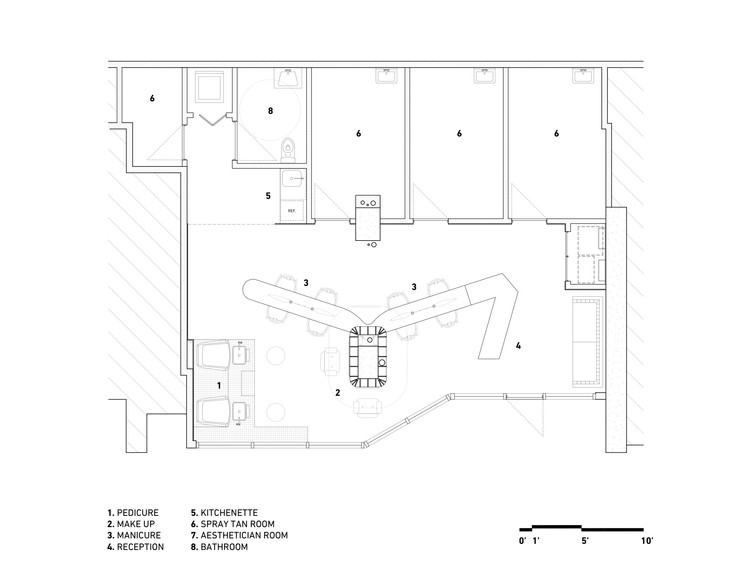Winnipeg Skating Shelters Patkau Architects
2011-05-17 00:00
架构师提供的文本描述。温尼伯是一座有60万居民的城市,位于加拿大草原上。它是西伯利亚以外面积最冷的城市。冬天可以持续六个月。因此,学会庆祝冬天-学会利用冬天提供的机会-是有意义的。
Text description provided by the architects. Winnipeg is a city of 600,000 residents located on the Canadian prairie. It is the coldest city of its size outside of Siberia. Winter can last six months. So learning to celebrate winter - learning to take advantage of the opportunities that winter provides - makes sense.
红河和阿西尼博因河在市中心汇合,在冬天,当被雪覆盖时,许多英里长的溜冰小径被创造出来。但是随着温度长时间下降到零下30度和40度,以及能使零下30度感觉像负50度的风,创造了躲避风的机会,大大提高了使用河流溜冰场的能力。因此,制定了一项计划,资助沿溜冰场的临时庇护所的设计和建造。
The Red and the Assiniboine Rivers meet in the centre of the city, and in winter, when plowed of snow, skating trails many miles long are created. But with temperatures that drop to minus 30 and 40 for long periods of time, and winds that can make minus 30 feel like minus 50, creating opportunities to find shelter from the wind greatly enhances the ability to use the river skating trails. Therefore, a program has developed to sponsor the design and construction of temporary shelters located along the skating trails.
我们的建议包括一组亲密的庇护所,每个收容所一次只能容纳几个人。他们被分组在一个小的‘村庄’(或‘牧群’,‘学校’,‘羊群’,或‘船队’)组成一个集体。。。“某物”。。。不能用单一的解释。他们像水牛一样背对着风站着,似乎有生命和目标,因为他们挤在一起,保护彼此不受各种因素的影响。
Our proposal consists of a cluster of intimate shelters, each accommodating only a few people at a time. They are grouped in a small ‘village’ (or ‘herd’, or ‘school’, or ’flock’, or ‘flotilla’) to form a collective . . . of ‘something’ . . . irreducible to a single interpretation. They stand with their backs to the wind like buffalo, seeming to have life and purpose as they huddle together shielding each other from the elements.
每个掩体都是由薄而灵活的胶合板组成,通过弯曲/变形,这种胶合板既有结构,也有空间特性。皮,由2层3/16英寸厚的柔性胶合板制成,被切割成图案,并附在一个由三角形基座、楔形脊柱和脊构件组成的木材电枢上。(山脊是一条线,用来抵消雪的重力负荷。)在我们的实验车间里,用一个全尺寸的原型绘制了弯曲的应力图.通过一系列的切割和开口,应力点得到了缓解。掩体的形式是这个过程的结果,压力/变形,然后释放压力。
Each shelter is formed of thin, flexible plywood which is given both structure and spatial character through bending/deformation. Skins, made of 2 layers of 3/16th inch thick flexible plywood, are cut in patterns and attached to a timber armature which consists of a triangular base, and wedge shaped spine and ridge members. (The ridge is a line to negate the gravity loads of snow.) Experiments in our workshop with a full-scale prototype mapped the stresses of bending. Stress points were relieved by a series of cuts and openings. The form of the shelter is a resultant of this process of stressing/deforming and then releasing stress.
将避难所分组为一组,首先是两者之间的关系,以及两者并置,以限定它们的入口开口的大小和可达性。这种看似随意的配对实际上是通过精确的120度旋转来实现的。然后,通过90度的二次旋转,将三对(一对具有反射镜反射)放置在一起,形成星团,并在更大的分组内定义中间的“内部”空间。这些庇护所共同创造了动态的太阳能/风能关系,这种关系根据特定的方向、时间和环境情况而变化。
Grouping the shelters into a cluster begins with the relationship of two, and their juxtaposition to qualify the size and accessibility of their entrance openings. This apparently casual pairing is actually achieved by a precise 120 degree rotation. Three pairs (one with mirror reflection) are then placed in relation to one another through a secondary rotation of 90 degrees to form the cluster and define an intermediate ‘interior’ space within the larger grouping. Together, the shelters create dynamic solar/wind relationships that shift according to specific orientation, time of day and environmental circumstance.
 举报
举报
别默默的看了,快登录帮我评论一下吧!:)
注册
登录
更多评论
相关文章
-

描边风设计中,最容易犯的8种问题分析
2018年走过了四分之一,LOGO设计趋势也清晰了LOGO设计
-

描边风设计中,最容易犯的8种问题分析
2018年走过了四分之一,LOGO设计趋势也清晰了LOGO设计
-

描边风设计中,最容易犯的8种问题分析
2018年走过了四分之一,LOGO设计趋势也清晰了LOGO设计












































